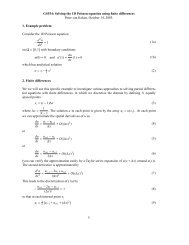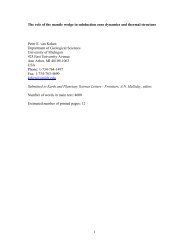Quantitative paleoenvironmental and paleoclimatic reconstruction ...
Quantitative paleoenvironmental and paleoclimatic reconstruction ...
Quantitative paleoenvironmental and paleoclimatic reconstruction ...
Create successful ePaper yourself
Turn your PDF publications into a flip-book with our unique Google optimized e-Paper software.
ARTICLE IN PRESS<br />
12 N.D. Sheldon, N.J. Tabor / Earth-Science Reviews xxx (2009) xxx–xxx<br />
redox gradient, because while U 4+ is insoluble under oxidizing<br />
conditions, U 6+ is soluble. Thus, during weathering, a few scenarios<br />
are possible that may give insight into both provenance <strong>and</strong> pedogenesis.<br />
The first is that U is leached away during pedogenesis <strong>and</strong> Th<br />
remains, leaving the upper horizons of the soil/paleosols with lower<br />
U/Th ratios than the parent material. This would indicate very intense<br />
weathering <strong>and</strong> a strong redox gradient. If the U is redistributed by<br />
lessivage rather than leached away, then the U/Th ratio should be<br />
highest in Bw/Bt horizons, <strong>and</strong> elevated relative to the parent material<br />
ratio (e.g., supporting data from Sheldon, 2006a). Alternatively, if<br />
pedogenesis was not very intense <strong>and</strong> there was no significant redox<br />
gradient, then the U/Th ratio should be constant with depth in a soil<br />
(e.g., data in Condie et al., 1995). Measurements of modern weathering<br />
suggest that the second scenario, U redistribution <strong>and</strong> accumulation<br />
in soils, is most likely (van der Weijden <strong>and</strong> van der Weijden,<br />
1995; Pett-Ridge et al., 2007). Examples in paleosols can be found<br />
among diverse settings, including basalt-parent laterites (Kisakürek<br />
et al., 2004) <strong>and</strong> s<strong>and</strong>stone-parented Inceptisol-like palesols (Sheldon,<br />
2006a). However, Pett-Ridge et al. (2007) also demonstrate that<br />
U that has accumulated in paleosols that are more than 150 Ka old is<br />
largely derived from atmospheric deposition (i.e., aerosols) rather<br />
than from weathering of the parent material. Thus, the U/Th ratio is<br />
probably most useful in paleosols with short-moderate formation<br />
times (see Section 5.3.1 for ways to address this in paleosols).<br />
Another trace element of interest is Nb, which is a transition metal<br />
that exhibits similar chemical behaviour to V, Ti, <strong>and</strong> Zr, all of which<br />
are typically relatively immobile during weathering. Kurtz et al.<br />
(2000) studied a climosequence of soils developed on Hawaiian<br />
basalts that range in age from 0.3 to 4100 Ka, <strong>and</strong> found that Nb <strong>and</strong> Ta<br />
were essentially completely immobile during weathering whereas<br />
other refractive elements including Zr, Al, Hf, <strong>and</strong> Th all displayed at<br />
least some limited mobility, particularly in the older soils. Because Nb<br />
is more abundant than Ta, it is preferable as an immobile index<br />
element in mass balance calculations (see Section 5.3). Kahmann et al.<br />
(2008) found that Nb was also the least immobile element during<br />
pedogenesis of Mississippian paleosols when compared with a whole<br />
suite of different refractory elements <strong>and</strong> suggested that Nb could be<br />
used as an index element to evaluate gains <strong>and</strong> losses of other elements<br />
during pedogenesis.<br />
5.2.4. Rare earth elements<br />
The rare earth elements (REE) are the lanthanide series elements<br />
(atomic numbers 57–71). The REE have similar atomic radii <strong>and</strong> all<br />
share a trivalent state (though some are divalent <strong>and</strong> monovalent as<br />
well), <strong>and</strong> some are not particularly rare relative to other transition<br />
metals (e.g., Ce; Tyler, 2004). They may be separated according to<br />
mass into light REE (LREE; atomic masses b153: La, Ce, Pr, Nd, Sm, <strong>and</strong><br />
Eu) <strong>and</strong> heavy REE (HREE; atomic masses N153: Gd, Tb, Dy, Ho, Er, Tm,<br />
Yb, <strong>and</strong> Lu). As with the Earth's crust, LREE are typically more abundant<br />
than HREE in soils. REE values are typically normalized <strong>and</strong><br />
reported relative to some common st<strong>and</strong>ard such as the North American<br />
Shale Composite (NASC; Li, 2000) or to chondritic meteorites<br />
(Nakamura, 1974). The solubility of the REE elements is typically low<br />
at near neutral pHs (Li, 2000; see Wimpenny et al., 2007 for discussion<br />
on pH effects on REE <strong>and</strong> platinum group elements), with increasing<br />
solubility resulting from more acidic pHs (Tyler, 2004). Their leaching<br />
behaviour varies according to regional humidity. Extremely humid<br />
climates with acidic soils (Spodosols <strong>and</strong> laterites, e.g., Oxisols) may<br />
be leached of REE more than other elemental constituents (Tyler,<br />
2004), but otherwise, REE tend to accumulate during weathering (e.g.,<br />
Zhang et al., 2007). Also, evidence for leaching of REE in laterites is<br />
equivocal, because a number of studies have found that they actually<br />
accumulate even in those intensely weathered settings (e.g., Walter<br />
et al., 1995; Koppi et al., 1996; Nesbitt <strong>and</strong> Markovics, 1997; Braun<br />
et al., 1998; Hill et al., 2000), suggesting perhaps that podzolization<br />
leaches REE, but not in most cases of lateritization. Kahmann et al.<br />
(2008) also found a strong relationship between clay content <strong>and</strong><br />
trace element <strong>and</strong> REE accumulation even in Histosol-like paleosols<br />
(low pH, low Eh), lending further support to the idea that under most<br />
conditions, REEs will accumulate during pedogenesis. Thus, one<br />
application of REE chemistry to is assess weathering intensity, because<br />
if the formation times are similar, a more intensely weathered soil will<br />
show more enrichment in REE than a less intensely weathered soil (all<br />
other conditions being equal; Sheldon, 2006a). Sheldon (2006a) used<br />
REE data (among other indicators of leaching) to argue that there<br />
was a significant enhancement in chemical weathering across the<br />
Permian–Triassic boundary based on a nearly order of magnitude<br />
increase in abundance in both LREE <strong>and</strong> HREE in earliest Triassic<br />
paleosols as compared with latest Permian paleosols. Another<br />
application of this general principle (i.e., accumulation of REE during<br />
weathering) comes from a basalt-parented chronosequence in which<br />
Zhang et al. (2007) found the following relationship relating ΣREE<br />
(ppm) to formation time:<br />
<br />
<br />
Age 10 4 ΣREE − 105:2<br />
years =<br />
1:082<br />
ð10Þ<br />
where R 2 =0.95 for the empirical relationship. Though this relationship<br />
is probably only applicable to basalt-parented paleosols because<br />
of differences in initial (i.e., parent material) REE concentrations, the<br />
high precision that they report suggests that similar chronofunctions<br />
could be developed for other parent materials as well.<br />
Another potential application of REE geochemistry is as a means<br />
for determining provenance (Table 3). Sheldon (2006a <strong>and</strong> supplemental<br />
data) has proposed that the molecular ratios of Sm/Nd, La/Ce,<br />
<strong>and</strong> Yb/Lu are useful as a means for determining provenance because<br />
the elements in each pair are both relatively abundant in most<br />
potential silicate parent materials <strong>and</strong> because the solubility of all of<br />
the elements is similar. As with the U/Th ratio, under moderate<br />
weathering conditions, constant Sm/Nd, La/Ce, <strong>and</strong> Yb/Lu ratios<br />
would be expected in paleosol profiles when plotted against depth.<br />
Given the similar chemical behaviour of each of those element pairs,<br />
the paleosol value should match the parent material value quite<br />
closely if there are no additional sources of sediment (e.g., aeolian<br />
addition) <strong>and</strong> if they are derived from a common protolith. Thus, by<br />
comparing Sm/Nd, La/Ce, <strong>and</strong> Yb/Lu ratios as a function of paleosol<br />
depth, Sheldon (2006a) confirmed results from Ti/Al ratios that<br />
indicated that although there was a substantial increase in paleosol<br />
<strong>and</strong> sediment maturity across the Permian–Triassic boundary it could<br />
not be attributed to a shift in provenance, <strong>and</strong> was instead due to<br />
enhanced chemical weathering <strong>and</strong> leaching (based on total REE<br />
abundance <strong>and</strong> Ba/Sr ratios). These REE ratios for provenance are<br />
therefore useful both as a check on other provenance indicators <strong>and</strong> as<br />
an independent means for assessing other processes such as aeolian<br />
addition of dust.<br />
A final paleosols REE proxy that has been proposed is to use REE<br />
“fingerprinting” to identify fossil bones associated with particular<br />
paleosol horizons. This was proposed as a means for National Parks to<br />
determine whether or not bones for sale in rock <strong>and</strong> gem shops had been<br />
poached from National Park l<strong>and</strong>s. Trueman (1999) proposed that<br />
because the ionic radii of trivalent REEs are similar to Ca 2+ , they should<br />
be readily incorporated into bone apatite during early diagenesis.<br />
Applying this general principle, Metzger et al. (2004) found that REE<br />
signatures of bones, though highly variable within a site, were<br />
significantly enhanced compared to sites without paleosol formation.<br />
They further found that the greater degree of pedogenesis, the higher<br />
the HREE concentration was within bones, regardless of soil horizon, <strong>and</strong><br />
that fossil bone REE signatures from different depositional environments<br />
<strong>and</strong> different types of paleosols were distinguishable. There is<br />
some overlap in REE values between similar sites <strong>and</strong> similar paleosols,<br />
so while it is probably not possible to “fingerprint” sites to an absolute<br />
Please cite this article as: Sheldon, N.D., Tabor, N.J., <strong>Quantitative</strong> <strong>paleoenvironmental</strong> <strong>and</strong> <strong>paleoclimatic</strong> <strong>reconstruction</strong> using paleosols, Earth-<br />
Science Reviews (2009), doi:10.1016/j.earscirev.2009.03.004















